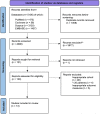Tracheostomy timing and outcome in critically ill patients with stroke: a meta-analysis and meta-regression
- PMID: 37005666
- PMCID: PMC10068163
- DOI: 10.1186/s13054-023-04417-6
Tracheostomy timing and outcome in critically ill patients with stroke: a meta-analysis and meta-regression
Abstract
Background: Stroke patients requiring mechanical ventilation often have a poor prognosis. The optimal timing of tracheostomy and its impact on mortality in stroke patients remains uncertain. We performed a systematic review and meta-analysis of tracheostomy timing and its association with reported all-cause overall mortality. Secondary outcomes were the effect of tracheostomy timing on neurological outcome (modified Rankin Scale, mRS), hospital length of stay (LOS), and intensive care unit (ICU) LOS.
Methods: We searched 5 databases for entries related to acute stroke and tracheostomy from inception to 25 November 2022. We adhered to PRISMA guidance for reporting systematic reviews and meta-analyses. Selected studies included (1) ICU-admitted patients who had stroke (either acute ischaemic stroke, AIS or intracerebral haemorrhage, ICH) and received a tracheostomy (with known timing) during their stay and (2) > 20 tracheotomised. Studies primarily reporting sub-arachnoid haemorrhage (SAH) were excluded. Where this was not possible, adjusted meta-analysis and meta-regression with study-level moderators were performed. Tracheostomy timing was analysed continuously and categorically, where early (< 5 days from initiation of mechanical ventilation to tracheostomy) and late (> 10 days) timing was defined per the protocol of SETPOINT2, the largest and most recent randomised controlled trial on tracheostomy timing in stroke patients.
Results: Thirteen studies involving 17,346 patients (mean age = 59.8 years, female 44%) met the inclusion criteria. ICH, AIS, and SAH comprised 83%, 12%, and 5% of known strokes, respectively. The mean time to tracheostomy was 9.7 days. Overall reported all-cause mortality (adjusted for follow-up) was 15.7%. One in five patients had good neurological outcome (mRS 0-3; median follow-up duration was 180 days). Overall, patients were ventilated for approximately 12 days and had an ICU LOS of 16 days and a hospital LOS of 28 days. A meta-regression analysis using tracheostomy time as a continuous variable showed no statistically significant association between tracheostomy timing and mortality (β = - 0.3, 95% CI = - 2.3 to 1.74, p = 0.8). Early tracheostomy conferred no mortality benefit when compared to late tracheostomy (7.8% vs. 16.4%, p = 0.7). Tracheostomy timing was not associated with secondary outcomes (good neurological outcome, ICU LOS and hospital LOS).
Conclusions: In this meta-analysis of over 17,000 critically ill stroke patients, the timing of tracheostomy was not associated with mortality, neurological outcomes, or ICU/hospital LOS.
Trial registration: PROSPERO-CRD42022351732 registered on 17th of August 2022.
Keywords: Critically ill; Haemorrhagic; Ischaemic; Mechanical ventilation; Stroke; Tracheostomy.
© 2023. The Author(s).
Conflict of interest statement
None.
Figures




Comment in
-
Early versus late tracheostomy: what do patients want?Crit Care. 2023 Apr 19;27(1):151. doi: 10.1186/s13054-023-04443-4. Crit Care. 2023. PMID: 37076935 Free PMC article. No abstract available.
-
The stroke care puzzle: Does tracheostomy timing fit?Crit Care. 2023 Jun 1;27(1):216. doi: 10.1186/s13054-023-04482-x. Crit Care. 2023. PMID: 37264477 Free PMC article. No abstract available.
References
Publication types
MeSH terms
Grants and funding
LinkOut - more resources
Full Text Sources
Medical
Miscellaneous

